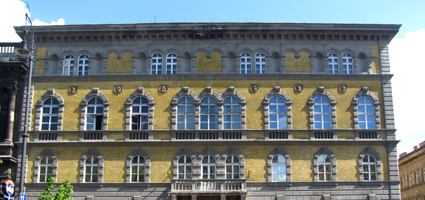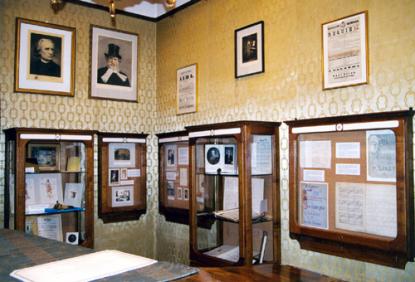2024. April 26. Friday
Liszt Ferenc Memorial Museum and Research Center - Budapest
 |
Address: 1064, Budapest Vörösmarty utca 35.
Phone number: (1) 342-7320, (1) 322-9804 /11611
E-mail: info@lisztmuseum.hu
Opening hours: Mon, Wed, Fri 10-18, Sat 9-17
|
The exhibition has closed for visitors.
2003.06.06. - 2003.10.17.
Museum tickets, service costs:
|
Ticket for adults
|
2000 HUF
|
|
|
Ticket for students
|
1000 HUF
|
|
|
Ticket for pensioners
|
1000 HUF
|
|
|
Group guide
(max. 30 people)
|
12000 HUF
|
/ group
|
|
Audio guide
|
700 HUF
|
The exhibition entitled "Bellini and Verdi in Liszt's transcriptions" is exposed in the middle room of the museum (documents on Verdi) and in the passage on the ground-floor (documents on Bellini). Both parts are built following the chronology of the Liszt-transcriptions, but beyond the transcriptions themselves we tried to give a wider music historical background, as well. Bellini's style paved the way to Verdi's operas, and the transcriptions made of their operas are landmarks in Liszt's oeuvre: from the late 30s, the first Bellini-transcirptions to his last opera transcription of the Simone Boccanegra passed more than forty years.

The two sections of the exhibition are connected by their Hungarian references: the Hungarian composer and conductor Ferenc Erkel made a lot of effort to perform the Italian operas in Hungary just a few years after their first performances. In the manuscript score of Bellini's Norma Erkel wrote his instructions regarding the performance. On the score his baton can be seen from the estate of the Hungarian National Opera.
Upstairs, in the Verdi section are exhibited the lithographies of the most famous singers by Miklós Barabás, they sang the leading roles in the Italian operas under Erkel's conducting. The Theatre Department of the National Széchényi Library lended the two original programs of the Aida and the Requiem, the performances, which Liszt was listening to. As far as we know, Liszt attended the performance of the Aida only in the Hungarian National Theatre, that's why in the case of this opera there are shown more Hungarian documents of the time, like stage and costume designs.
In the exhibition is demonstrated the only original Verdi manuscript in Hungary from the Music Department of the National Széchényi Library, it is an Albumblatt with Manrico's part from the Miserere-scene of the Trovatore, which scene was also transcribed by Liszt. This case is one of the two, where the visitor can follow the musical relationships, here namely how were the Miserere-compositions of the 19th century, among them by Verdi and by Liszt influenced by the tradition of the Cappella Sistina singing Allegri's Miserere.
The scores and manuscripts are from Liszt's estate at the Liszt Museum, from the Research Library of the Academy of Music and from the Music Department of the Széchényi Library, the medals, among them the silver coin (one scudo) with Verdi's most famous portrait on it are from the collection of the Museum of the Hungarian Institute of Musicology. During the visit of the Verdi-section in the museum music illustrations can be requested.

The two sections of the exhibition are connected by their Hungarian references: the Hungarian composer and conductor Ferenc Erkel made a lot of effort to perform the Italian operas in Hungary just a few years after their first performances. In the manuscript score of Bellini's Norma Erkel wrote his instructions regarding the performance. On the score his baton can be seen from the estate of the Hungarian National Opera.
Upstairs, in the Verdi section are exhibited the lithographies of the most famous singers by Miklós Barabás, they sang the leading roles in the Italian operas under Erkel's conducting. The Theatre Department of the National Széchényi Library lended the two original programs of the Aida and the Requiem, the performances, which Liszt was listening to. As far as we know, Liszt attended the performance of the Aida only in the Hungarian National Theatre, that's why in the case of this opera there are shown more Hungarian documents of the time, like stage and costume designs.
In the exhibition is demonstrated the only original Verdi manuscript in Hungary from the Music Department of the National Széchényi Library, it is an Albumblatt with Manrico's part from the Miserere-scene of the Trovatore, which scene was also transcribed by Liszt. This case is one of the two, where the visitor can follow the musical relationships, here namely how were the Miserere-compositions of the 19th century, among them by Verdi and by Liszt influenced by the tradition of the Cappella Sistina singing Allegri's Miserere.
The scores and manuscripts are from Liszt's estate at the Liszt Museum, from the Research Library of the Academy of Music and from the Music Department of the Széchényi Library, the medals, among them the silver coin (one scudo) with Verdi's most famous portrait on it are from the collection of the Museum of the Hungarian Institute of Musicology. During the visit of the Verdi-section in the museum music illustrations can be requested.
